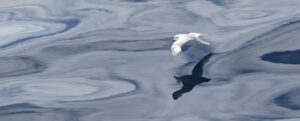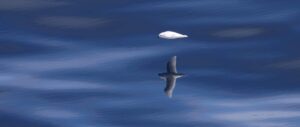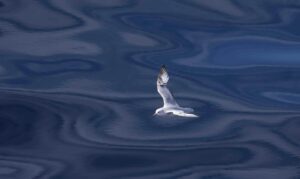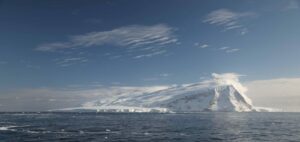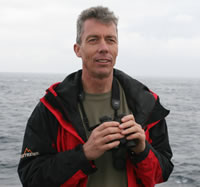By Peter Ryan, onboard scientist, expert in general ornithology, seabird-fishery interactions, evolutionary ecology, marine debris, solid waste management, biology of oceanic islands.
Leg 2: Balleny to Scott
On 5 February, we celebrated crossing the date line by re-living the day twice, after moving forward an hour and backwards a day. On this rather odd and protracted day, we travelled from the Balleny Islands to Scott Island over about 32 hours. The first 5 February dawned clear and calm, with the ship surveying for a ROPOS deployment site just offshore from Sturge Island, the southernmost and largest of the Balleny Islands. Even after two days of gawking at ice-covered volcanic islands, Sturge drew ‘oohs’ and ‘aahs’, and lots of pixels were burned. After deciding the current was too strong for ROPOS, we steamed for Scott, with a full CTD station in the afternoon among a sea of table icebergs. Few birds were active in the glassy conditions; the highlight for at least some of us was another Campbell Albatross (albeit briefly), although a small flock of juvenile Adelie Penguins also was quite cute. Hump-backed Whales were common near the Ballenys, then largely replaced by Antarctic Minke Whales as we headed east. A single Crabeater Seal swam past.
The ‘groundhog day’ version of 5 February was a more subdued affair, with the ship quiet as we were buffeted by southwesterly winds and protracted snowfall. The birding was very slow, with sometimes more than an hour between birds, and only one Minke Whale seen. However, things livened up considerably once we reached Scott Island around 16h40. Initial impressions were of a dirty iceberg through the snow, but as we got closer we could see its forbidding cliffs surrounded by crashing waves. There were few birds until we were right at the island, where we were surprised to find good numbers of Campbell Albatrosses (which frustratingly were not at all interested in the Akademik). There also were large flocks of Cape Petrels and Short-tailed Shearwaters, smaller numbers of Antarctic Prions, and a smattering of other species. Again, no kelp or litter was seen (other than from the ship), and water samples had few microplastics. The list for 5 February (extended) was:
| Short-tailed Shearwater | 320 | Cape (Pintado) Petrel | 175 |
| Antarctic Prion | 100 | Mottled Petrel | 43 |
| Campbell Albatross | 26 | Antarctic Fulmar | 13 |
| Snow Petrel | 10 | Wilson’s Storm Petrel | 9 |
| Antarctic Petrel | 8 | Adelie Penguin | 6 |
| Light-mantled Albatross | 5 | White-headed Petrel | 4 |
| Sooty Shearwater | 3 | Southern Giant Petrel | 2 |
| South Polar Skua | 1 | Antarctic Minke Whale | 21 |
| Hump-backed Whale | 8 | Crabeater Seal | 1 |
